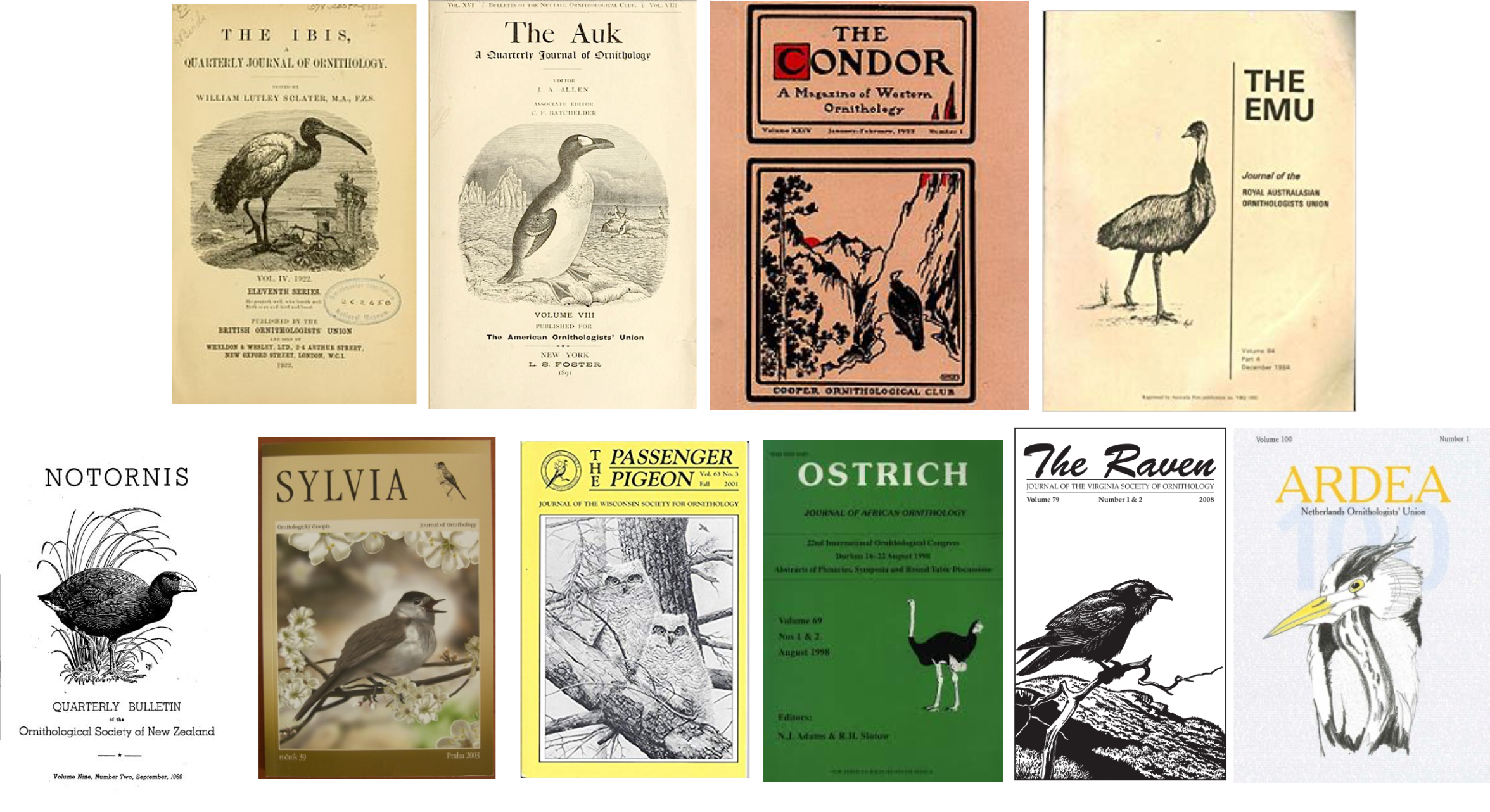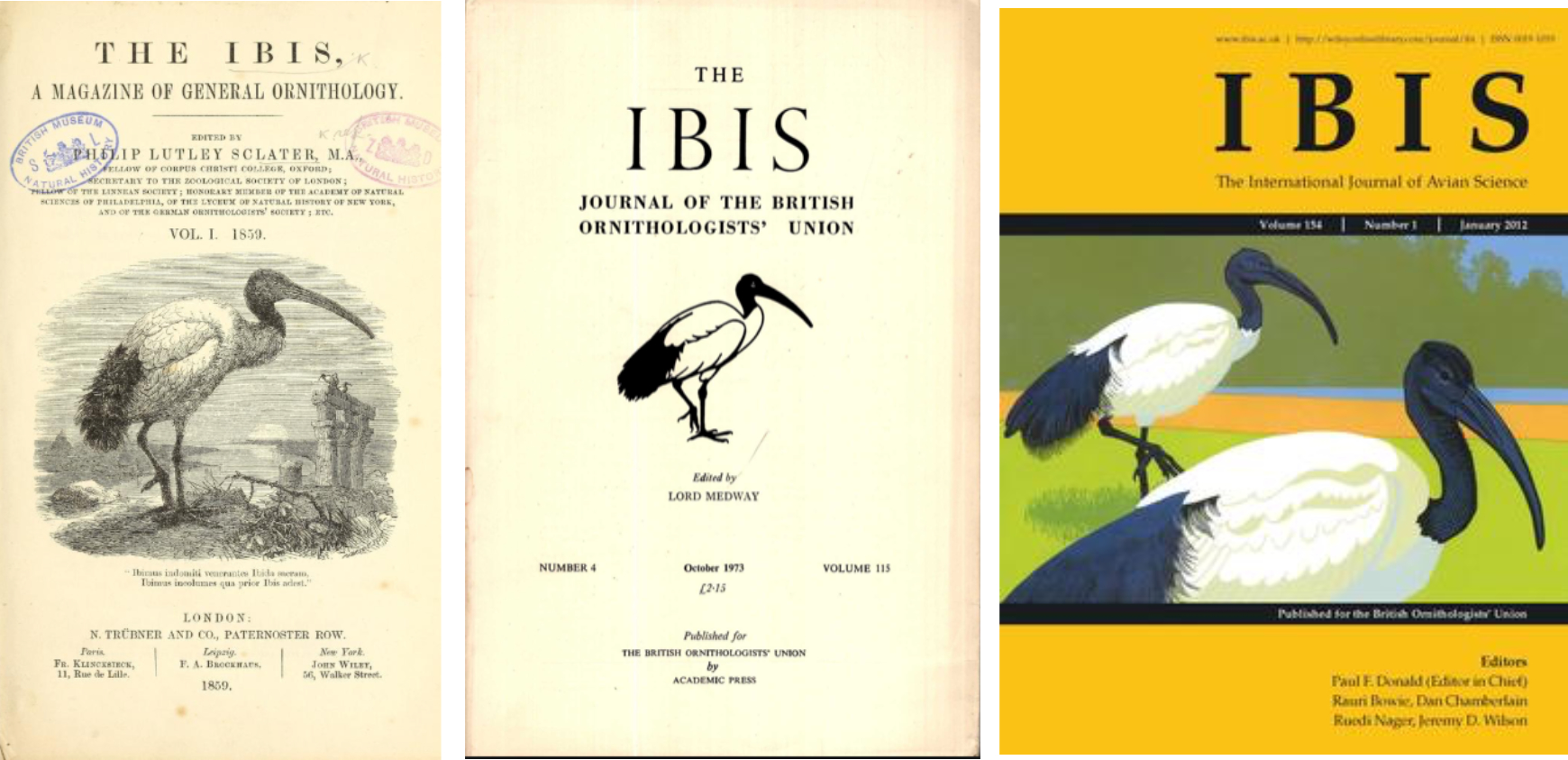Just after I had begun my current academic position, almost 40 years ago, my avuncular Head of Department thought he should tell me a little bit about the scientific publishing game. “Look,” he said “I know that you people who study birds like to publish in those journals with funny bird names—Ibis, Auk, Condor, Emu—but it’s not a good career move. Those journals sound like nature magazines. The higher-ups and the granting councils are not going to give you much, if any, credit, for publishing your work there. Better to publish in Evolution, Nature and Science, for example.” He didn’t like American Naturalist either, for the same reasons, and he recommended against books and reviews until I became more established.

He knew about those bird journals even though he was a plant physiologist because our department already had three rather well-known ornithologists on faculty—Allen Keast, Fred Cooke, and Raleigh Robertson. Fortunately, I did not pay much attention to his advice—I just published two papers in The Ibis and The Auk this year, for example—but I often hear from colleagues in North America and Europe that they worry about publishing in those bird-named journals.
But where did those names come from, and why have we cherished them for so long? I have no insights whatsoever into the second part of that question and it may need a socio-psychological analysis. Even the first part of that question is a tough one to answer. Let’s begin with The Ibis, maybe the first scientific journal to be named after an organism [1].
There has been a suggestion that the name ‘Ibis’ was a mistake made by the man hired to print the journal on mis-hearing the name ‘Aves‘ suggested by the founders of the BOU [2]. This seems highly unlikely as the founders almost certainly communicated with the printer by mail. Moreover, the printer was William Francis who was very interested in birds and had already been involved in the printing of bird books by John Gould and others. In a letter to Alfred Newton, Philip Sclater makes it clear that Francis not only did not suggest the name ‘Aves’ here didn’t even like it: “Dr Francis (our printer) objects to the title of Aves, and I think with reason. He suggests ‘The Ibis’ the sacred bird of the Egyptians – and emblematic of birds in general. Will this do! I think yes’” [3]. Here is Sclater, again, reminiscing on the 50th anniversary of the journal:
Messrs. Triibner & Co., of Paternoster Row, with whom I was well acquainted, agreed to publish it, and Messrs. Taylor & Francis to print it. From the head of the latter firm, the late Dr. William Francis — a very capable and well-informed person, — I received the excellent suggestion to call our new bantling ‘The Ibis,’ after the sacred bird of Egypt. I at once adopted the idea, with which Newton also was highly pleased, and we set Joseph Wolf (then in the zenith of his fame) to work to draw the well-known wood-block which appeared in the first number of ‘The Ibis’ and has ever since ornamented its cover. [3]

So it was the printer who suggested the name to Alfred Newton, possibly because the African Sacred Ibis was quite a famous bird in the mid-1800s [4]. Newton thought the name was fine: ‘as for the name itself I don’t think it signifies twopence, and Ibis is as good as any other’ [5]. John Wolley, another of the founders of the BOU, disagreed, however, and threatened to withdraw as a founding member [6]. I wonder if Wolley considered the name to be odd, as the eponymous ibis did not occur in Britain, or even in Europe for that matter, and thus must have seemed an odd choice to symbolize the BOU. Indeed, at the centenary conference of the BOU in 1959, Ernst Mayr joked that:
…we have this quite miraculous situation that the two national journals are named in the most appropriate manner: the British one is named for that well-known British bird, the Ibis, and the other journal is named for that North American species, the Great Auk. If I may for a moment continue in this frivolous mood (which really does not belong to this subject), I would like to say I think the Australians really missed the boat. They had an opportunity to combine the unique features of the title of the American journal and of the British journal, and name their own national journal for an exotic bird that was extinct-and call it the Dodo. [7]
The founders and members of the BOU long took pride in the name of their new journal, I think in part because it suggested a global reach and honoured a storied bird. In those early days they called themselves ‘Ibises’ and referred to The Reverend Henry Tristram, one of the founders, as ‘The Sacred Ibis’ [8]. At that centenary conference, Erwin Stresemann mused about the reverence of the journal’s name:
Comparative zoologists must agree that to symbolize an ornithological journal no better emblem could have been chosen than ancient Egypt’s most sacred bird. Almost two thousand years ago the Roman writer Claudius Aelianus produced some kind of natural history of birds. According to him, the Ibis enjoys freedom from sickness, longevity or even immortality. Our bird was sacred to such a degree that the Egyptian priests washed in water from which it had drunk. This kind of adoration still persists. In our days the priests of ornithology—whether in Eurasia or in Africa, in America or in Australia—behave after the fashion of their colleagues in the land of Pharaoh: they worship the healing water that emanates from the Ibis every three months. [9]
That reverence—and its religious overtone—is also reflected in the series of sayings [10] that appeared below the Wolf woodcut on the journal’s cover at least until 1924. With almost every new series of the early Ibis, the editors (presumably) chose or wrote a latin phrase that either included the word ‘Ibis’ or made some allusion to the importance of birds. For a 30-year period (1889-1918) took these from The Vulgate, a 4th-century Latin translation of the Christian Bible:
- 1859: Ibimus indomiti venerantes Ibida sacram, / Ibimus incolumes qua prior Ibis adest. “We shall go undaunted, worshiping the sacred ibis; we shall go safely where the ibis awaits.” [ed. Philip Lutley Sclater]
- 1865 (start of 2nd series): Ibidis interea tu quoque nomen habe! “Meanwhile take the name ibis for yourself.” From Ovid’s poem “The Ibis”. [ed. Alfred Newton]
- 1871 (start of 3rd series): Ibidis auspicio novus incipit Ibidis ordo! “Under the good auspices of the ibis, a new order begins for the Ibis.” [ed. Osbert Salvin]
- 1877 (start of 4th series): Ibis avis robusta et multos vivit in annos. “The ibis is a sturdy bird and lives for many years.” [eds. O. Salvin and P. L. Sclater]
- 1889 (start of 6th series): Cognovi omnia volatilia caeli. “I know all the things that fly under heaven.” From Psalm 50. [ed. P. L. Sclater]
- 1895 (start of 7th series): Non moriar, sed vivam, et narrabo opera Domini. “I shall not die, but live, and I shall tell of the works of the Lord.” From Psalm 117. [eds. P. L. Sclater and H. Saunders]
- 1901 (start of 8th series): Quam magnificata sunt opera tua, Domine. “How great are your works, oh Lord.” From Psalm 91. [eds. P. L. Sclater and Arthur Humble Evans]
- 1907 (start of 9th series): Delectasti me, Domine, in operibus manuum tuarum. “You have delighted me, Lord, with the works of your hands.” This is an abridged bit from Psalm 92. [eds. P. L. Sclater and A. H. Evans]
- 1919 (start of 11th series): He prayeth well, who loveth well/Both man and bird and beast. From Samuel Taylor Coleridge’s ‘Rime of the Ancient Mariner’, presumably suggesting that we should love birds as we love ourselves. [ed. William Lutley Sclater (Philip’s eldest son)]

My old head of department would not doubt be scandalized to discover that our birdy journals continue to flourish despite their names, and that I continue to (or at least try to) publish some of my best work there. He would certainly be shocked to find that the Canadian Journal of Biochemistry, that he once edited, has approximately the same Impact Factor as The Ibis, The Auk and The Condor, indicating that our bird-named journals make just as substantial a contribution to their branch of science.
The most recent journal impact factors (for 2016) indicate that bird-named journals are at the top of the list of 24 ornithology journals with The Condor and The Ibis holding down the number 1 and 2 spots, and 3 of the top 5 spots. Thus there is really no evidence that publishing in one of those bird-named journals is in any way detrimental (given that you are going to publish in an ornithology journal). There has long been a move afoot to drop the names Auk and Condor from the AOS journals, but it would be a shame, I think, to erase that quirky little bit of ornithological history.
SOURCES
- Anoymous (1959) The centenary banquet in London. Ibis 101: 281-289
- Bircham P (2007) A History of Ornithology. London: Collins.
- Birkhead TR, Gallivan PT (2012) Alfred Newton’s contribution to ornithology: a conservative quest for facts rather than grand theories. Ibis 154:887–905.
-
Hale WG (2016) Sacred Ibis: The Ornithology of Canon Henry Baker Tristram, DD, FRS. Sacristy Press.
- Moreau RE (1959) The centenarian ‘Ibis’. Ibis 101:19–38.
- Mountfort G (1959) One hundred years of the British Ornithologists’ Union. Ibis 101:8–18.
- Sclater PL (1909) A short history of the British Ornithologists’ Union. Ibis 50:19–70.
Footnotes
- journal named after an organism: certainly the first major ornithological journal (in 1859), followed by The Auk (in 1884), The Condor (in 1899), The Emu (in 1901), and Ardea (in 1912)
- journal named ‘Aves’: see Bircham 2007 page 191, Birkhead and Gallivan 2012 page 890
- Sclater quotations: letter to Newton from Birkhead and Gallivan 2012 page 890; about the Ibis cover from Sclater 1909 page 20
- sacred ibis was a famous bird: see last week’s post here;
- Newton quotation: from Bircham 2007 page 191
- Wolley disagreed about Ibis: see Bircham 2007 pages 190-191, Birkhead and Gallivan 2012 pages 890-891
- Mayr quotation: from Anonymous 1959 page 283
- Tristram as the sacred ibis: see Hale 2016
- Stresemann quotation: from Anonymous 1959 page 282
- sayings: Rick Wright blogged about these here, and I have used many of his translations
Bob,
The worth of our recent book (Birds of Nunavut) would certainly suffered had it not been for articles in The Auk, and to a lesser degree, The Wilson Bulletin.
While on the subject, I hasten to add that we would have lost much valuable information had it not been for The Canadian Field-Naturalist entries.
Cheers,
Jim Richards